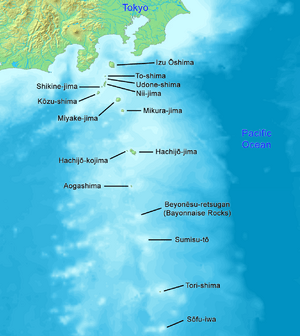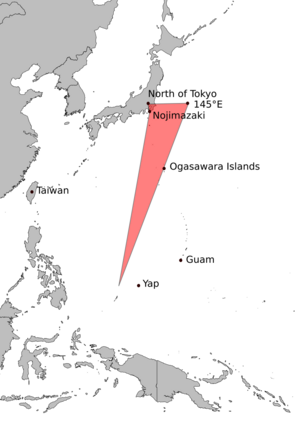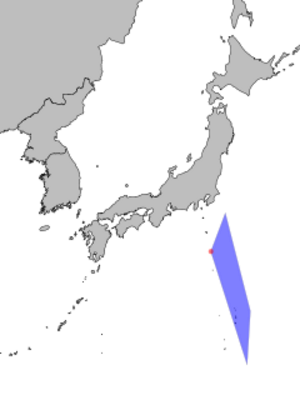Devil's Sea facts for kids
The Devil's Sea, also known as the Dragon's Triangle, is a mysterious area in the Pacific Ocean. It is located south of Tokyo, near the Izu Islands. For many years, people have told stories about ships and planes disappearing without a trace in this region. Some believe it is a paranormal place, full of unexplained events, while others look for scientific reasons.
Contents
What is the Devil's Sea?
The Japanese call this area Ma no Umi, which means "Sea of the Devil," "Troublesome Sea," or "Dangerous Sea." This name has been used for many dangerous parts of the ocean around the world. The Devil's Sea is also sometimes called the "Pacific Bermuda Triangle" because of its similar reputation for strange disappearances.

Tales of Disappearance
Stories about strange events in the Devil's Sea have been shared for decades.
- In August 1945, near the end of World War II, a Japanese Mitsubishi A6M Zero airplane was said to have gone missing. The pilot's last radio message reportedly mentioned something unusual happening in the sky.
- On January 4, 1955, a Japanese ship called Shinyo Maru No. 10 lost radio contact near Mikura-jima. Japanese newspapers began calling the area ma no umi. Luckily, the ship was found safe on January 15.
- Around this time, newspapers like Yomiuri Shimbun showed maps of the sea. They pointed out where several other ships had been lost. They said these losses happened in an area the Yokohama Coast Guard Office called a "special danger area."
- In the U.S., The New York Times reported on these incidents. They used the term "The Devil's Sea" and mentioned nine ships lost in good weather.
Charles Berlitz and the Dragon's Triangle
In 1974, an American writer named Charles Berlitz wrote a popular book called The Bermuda Triangle. In this book, he also wrote about the Devil's Sea. Berlitz claimed that many modern ships and hundreds of crew members disappeared without a trace between 1950 and 1954. He also said that in 1955, the Japanese government sent a research ship, the Kaiyo Maru No. 5, to investigate. According to Berlitz, this ship also vanished. He stated that after this, Japanese authorities labeled the sea as a danger zone. Later, in 1989, Berlitz wrote another book, The Dragon's Triangle. He claimed that five Japanese military ships disappeared during training near Japan in early 1942. These stories made the Devil's Sea, or Dragon's Triangle, famous around the world.
Investigating the Devil's Sea Claims
Many people were fascinated by these stories. However, researchers began to look closer at the facts.
Larry Kusche's Research
In 1975, an American author named Larry Kusche published a book called The Bermuda Triangle Mystery Solved. He looked into the claims about the Devil's Sea.
- Kusche contacted government offices related to the sea. He found that no one knew about a specific "Devil's Sea" or a large official danger area.
- The actual danger zone warned by the Maritime Safety Agency of Japan was a small area, only about 10 miles around Myōjin-shō. This was because of an active undersea volcano.
- The Kaiyo Maru No. 5 research ship did disappear, but it was in 1952, not 1955. It was sent to Myōjin-shō to study the undersea volcano. The ship was lost due to a volcanic eruption, which was a known natural event. It carried 31 people, not 100 as some stories suggested.
- Kusche also found that most of the other "lost" ships were small fishing boats. Many had poor or no radio equipment. The weather during their disappearances was often not "perfect" as claimed, but stormy or rough.
- He also discovered that some of the "military vessels" Berlitz mentioned were actually fishing boats. Some of these even sank outside the area Berlitz described as the Dragon's Triangle.
The Origin of the Legend
Writer Daniel Cohen mentioned in his 1974 book Curses, Hexes & Spells that legends of the Dragon's Triangle went back centuries in Japan. However, researcher Brian Dunning of Skeptoid looked for old books, newspapers, and magazine articles about the Dragon's Triangle. He found nothing until about 20 years after the Kaiyō-Maru disappeared in 1952. This suggests that the idea of a legendary "Dragon's Triangle" might be a more recent story, not an ancient one.
Natural Explanations for Disappearances
Scientists and researchers have explored natural events that could explain some of the mysterious disappearances in this region.
- Undersea Volcanoes: The Devil's Sea area is very active with undersea volcanoes. It's common for small islands to appear and disappear due to volcanic eruptions and seismic activity (earthquakes). These powerful natural events can be very dangerous for ships.
- Methane Hydrates: The ocean floor in the Dragon's Triangle area contains large amounts of methane hydrates. These are like icy deposits of gas. If the water temperature rises above 18°C (64°F), these methane gases can "explode" from the seafloor. They rise to the surface as huge bubbles. These gas eruptions can make the water less dense, causing a ship to suddenly lose its buoyancy (ability to float). A ship could sink very quickly without leaving any trace.
It's important to remember that the exact location of the "Dragon's Triangle" is not on any official world map. Its boundaries change depending on who is describing it. This makes it harder to study specific events within a defined area.



